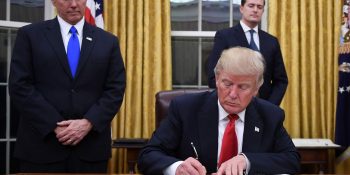TRUMP ORDERS GAG ON U.S.D.A. & Environmental Protection Agency
“Starting immediately and until further notice” the department’s main research divisions of the USDA and Environmental Protection Agency “will not release any public-facing documents. This includes, but is not limited to, news releases, photos, fact sheets, news feeds, and social media content,” according to an internal memo sent to BuzzFeed News.
The message was handed down to the Agricultural Research Service (ARS) from the Environmental Protection Agency and US Department of Agriculture just days after Donald Trump was sworn into office as President. A couple of other agencies have been put on an order to obtain ‘prior authorization’ over what they are allowed to share with the public, among them is the Environmental Protection Agency. Confirmation of this report from the new Administration is still pending. Neither the USDA or EPA has blogged, twittered or posted any news or updates since.
What does this mean?
The ARS is the main research agency of the USDA and is tasked with “finding solutions to agricultural problems that affect Americans every day from field to table.” The memo outlining these new rules has not been made public, but the ban reportedly includes everything from summaries of scientific papers to USDA-branded tweets. Scientists are still able to publish their findings in peer-reviewed journals, but they are unable to talk about that research without prior consent from their agency.
How much does public science really shape our lives? For instance, the weather app on your phone projects rain with minute-by-minute precision—or warn you about an impending tornado—is underpinned by government science (in this case by the National Weather Service). The reach of government science isn’t just limited to the weather however. Government science is what determines which strain of flu should go into each year’s flu vaccine. It’s what helps us avert pandemics and helps farmers maximize the yield of foods that feed us and exports too. The work of Cooperative Extension exists to improve the livelihood of farmers, which is underpinned by government science. The research has value because of its dissemination to the public. When science isn’t released and discussed, we can’t make decisions based on it.
Who is the USDA?
The Unites States Department of Agriculture is governed by the Executive Branch of our Government. USDA‘s Mission: “Enhance the quality of life for the American people by supporting production of agriculture; ensuring a safe, affordable, nutritious, and accessible food supply; caring for agricultural, forest, and range lands; supporting sound development of rural communities; providing economic opportunities for farm and rural residents; expanding global markets for agricultural and forest products and services; and working to reduce hunger in America and throughout the world.”
Through inspection and grading, the U.S. Department of Agriculture enforces standards for wholesomeness and quality of meat, poultry and eggs produced in the United States. USDA food safety activities include inspecting poultry, eggs, and domestic and imported meat; inspecting livestock and production plants; and making quality (grading) inspections for grain, fruits, vegetables, meat, poultry and dairy products. USDA’s education programs target family nutritional needs, food safety and expanding scientific knowledge. The department supports education with grants in food and agricultural sciences and conducts its own and cooperative food research.
-
A number of research and public programs are housed under the USDA, for instance, WIC, SNAP, and Food Security. A complete list can be found here.
Who Is the EPA?
According to their website, the Environmental Protection Agency aims to:
- Develop and enforce regulations
When Congress writes an environmental law, we implement it by writing regulations. Often, we set national standards that states and tribes enforce through their own regulations. If they fail to meet the national standards, we can help them. We also enforce our regulations, and help companies understand the requirements.
- Give grants
Nearly half of our budget goes into grants to state environmental programs, non-profits, educational institutions, and others. They use the money for a wide variety of projects, from scientific studies that help us make decisions to community cleanups. Overall, grants help us achieve our overall mission: protect human health and the environment.
- Study environmental issues
At laboratories located throughout the nation, we identify and try to solve environmental problems. To learn even more, we share information with other countries, private sector organizations, academic institutions, and other agencies.
- Sponsor partnerships
We don’t protect the environment on our own, we work with businesses, non-profit organizations, and state and local governments through dozens of partnerships. A few examples include conserving water and energy, minimizing greenhouse gases, re-using solid waste, and getting a handle on pesticide risks. In return, we share information and publicly recognize our partners.
- Teach about the environment
Protecting the environment is everyone’s responsibility, and starts with understanding the issues. The basics include reducing how much energy and materials you use, reusing what you can and recycling the rest. There’s a lot more about that to learn!
- Publish information
Through written materials and this website, EPA informs the public about our activities.
For more information about what the EPA’s Mission and Purpose is visit their website here. For more information about what the USDA’s Mission and Purpose is visit their website here.

Leave a Reply